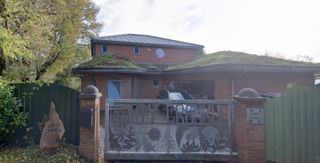How these self builders could only get a 'D' EPC rating — despite building an eco home
Assessors refused to accept their SAP calculations and said they would only base the rating on "what they could see". As a result their insulation U value of 0.1W/m2K was ignored as well as photographs and air tightness certificates

A couple seeking to sell their home were left shocked when they received a 'D' EPC rating, despite the home receiving a 'C' rating when it was built in 1994.
The couple claim the home has high insulation levels with a U-value (the rate at which homes lose heat) of just 0.1W/m2K and includes an air source heat pump.
An EPC assessor produced a Reduced Data Standard Assessment Procedure (RdSAP) that "assumptions" had to be made which meant they did not inspect the property, but made their judgements on what they could see, which has called into question the efficacy of RdSAP EPC ratings.
Here we explainwhat is an EPCrating, what the difference is between SAP and RdSAP's and the potential issues you can face with RdSAP's.
What is an EPC rating?
An EPC rating, also known as an Energy Performance Certificate rating, helps homeowners find out theirhomes energy ratingand its energy efficiency.
The rating is based on an assessment of various factors such as the building's insulation, heating system, ventilation, and energy usage.
The EPC rating is represented on a scale from A to G, with A being the most energy-efficient and G being the least efficient. The ratings provide an indication of the energy consumption and carbon dioxide emissions of a building.
EPC ratings are typically required when a property is sold, rented out, or constructed.
The ratings can also highlight potential areas for improvement, such as upgrading insulation or replacing inefficient heating systems, which can lead to energy savings and lower utility bills.

How does a RdSAP rating differ from a SAP?
SAP calculations(Standard Assessment Procedure) are the methodology used by the government to assess and compare the energy and environmental performance of new builds, conversions and extensions.
The RdSAP is a simplified version of SAP used to assess energy performance of existing dwellings.
An RdSAP assessment will use a set of assumptions about the dwelling based on conventions and requirements at the time it was constructed. RdSAP's are required every 10 years to reassess home's energy performances.
RdSAP 2012is the current version used to produce assess energy performance in existing dwellings.
Couple received rating lower than when it was built
The couple were seeking to sell their home and so sought an up-to-date EPC assessment through Elmhurst Energy, who run the accreditation scheme.
The EPC assessor produced a RdSAP EPC which rated the property as 63, Band D; despite the EPC rating being 78, Band C, when the home was built.
This, the couple claim, is backed by full detailed SAP calculations, air tests, Building Control, and photographs.
The couple also claim the property has high levels of insulation including a super-insulated floor (Springvale Platinum Beamshield Plus with a U value of 0.10 W/m2K). The RdSAP EPC makes no rating on this even though there is a space for this.





The house has also been fitted with additional features since it was built, such as:
- Anair source heat pump(Nibe Fighter F2015 8.5 kW) as well asunderfloor heating
- Heat and vent recovery system - Villavent VR400 DCV/B with DC motor
- Beam and polystyrene block floor - Cube6 with a 0.1 W/m2K
- Green roofaids reduction in solar gain in summer
- Garage fully insulated to same standard as house (except floor), with an insulated door
- Rainwater recycling system with underground tank
- Inner walls hard plastered to assist in thermal mass heat stabilisation
'RdSAP EPC is not worth the paper it is printed on'
Julian Moss, one of the homeowners, claims the "RdSAP EPC is not worth the paper it is printed on".
She stated: "We still have all evidences for the original EPC (including the original EPC) such as invoices, photographs, air tests, full SAP calcs etc. The 'assumed' energy consumption figure is almost double the real world figure. The property has been well maintained, and no alterations to the building fabric carried out since the 'as built' tests, checks and calculations were completed."
She wrote to Elmhurst Energy claiming: "RdSAPs appear to be pseudo-science and have no real validity regarding energy performance; you should not be permitted to issue certificates based on these using the nomenclature EPC.
"An RdSAP EPC is an utter misnomer, it is not an Energy Performance Certificate by any stretch of the imagination; a real SAP uses real science and calculations, not assumptions, to allow for the issuing of a real EPC.
"Whilst changes may occur to a property over time, the original EPC clearly is far more meaningful and accurate than the suggested RdSAP EPC replacement. It seems that the RDSAP EPC is a misleading waste of time and can only take room measurements and 'assumptions' into consideration, not evidence."
She went on to say: "It is time RdSAP EPCs are cancelled".
EPC rating 'in line' with current policy
Despite these claims Elmhurst Energy have backed their rating Band D for the home after writing to the couple explaining their decision.
Tony Robinson, the Existing Dwellings Technical Consultant at Elmhurst Energy, wrote to Julian to justify the decision, claiming: "Variations in score (EPC rating) are not uncommon although I accept that the variation here is larger than we often see."
He explained: "This assessment requires a site inspection and the assessor records the physical characteristics of the property, walls heating etc. It is a non invasive survey and because the assessor does not have full access to the all structural elements (the full makeup of the wall for example) they cannot they make the detailed calculations used in SAP, hence reduced data.
"The U values in this case are normally derived from the properties characterises and are based on calculations of made by the Building Research Establishment (BRE) of typical properties of the type recorded. These typical value may well be less that the U values recorded in the SAP EPC.
"Regrettably therefore I have to advise that the EPC [the assessor] is proposing does seem to be broadly in line with the current methodology and whilst this will develop over time we are unfortunately where we are at the present time."
RdSAP's called 'crazy' by expert
The claims by this couple have been backed by experts who have called into question the accuracy of RdSAP's, and EPC's in general.
David Hilton, Homebuilding & Renovating's heating expert commented on this couple's RdSAP assessed EPC rating, claiming: "It is crazy that the efficiency of a premium home is solely down to what you can see."
He claims this "makes a mockery of trying to build better as any resale will need an EPC which will be only as good as building regulations, if that. Apparently, a heat pump is regarded as direct electric because there is no heat pump on the software."
A report earlier this year also showed EPC ratings "to be staggeringly inaccurate"after reviewing 17,000 homes energy usage showing their energy usage is 91% lower than what their EPC's claim they use.
住宅建筑的其他能源专家蒂姆•普伦so stated, "the methodology currently used to produce them (EPC's) does not instil any confidence in their accuracy or efficacy” and suggested "the software used to generate EPCs are ridiculous".
Julian Moss has requested an "accurate EPC" is done on the couple's home and has requested Grant Shapps, Secretary of State for Energy Security and Net Zero, to "immediately suspend RdSAP EPCs and replace them in the near future with a more scientific based alternative".
The government is currently working on an RdSAP update (RdSAP 10.2), which is expected to be published soon.
Get the Homebuilding & Renovating Newsletter
Bring your dream home to life with expert advice, how-to guides and design inspiration, direct to your inbox.

News Editor Joseph has previously written for Today’s Media and Chambers & Partners, focusing on news for conveyancers and industry professionals. Joseph has just started his own self build project, building his own home on his family’s farm with planning permission for a timber frame, three-bedroom house in a one-acre field. The foundation work has already begun and he hopes to have the home built in the next year. Prior to this he renovated his family's home as well as doing several DIY projects, including installing a shower, building sheds, and livestock fences and shelters for the farm’s animals. Outside of homebuilding, Joseph loves rugby and has written for Rugby World, the world’s largest rugby magazine.
Most Popular

BySam Webb

BySam Webb
Bring your dream home to life with expert advice, how-to guides and design inspiration, direct to your inbox.
Thank you for signing up to Homebuilding. You will receive a verification email shortly.
There was a problem. Please refresh the page and try again.